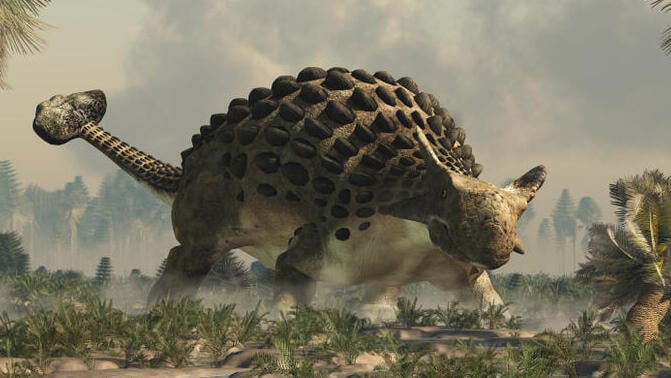Round 262 million years in the past, in the course of the center Permian Interval, a brand new household of reptiles emerged. Pareiasaurs – which means “cheek lizards”, a reference to the flat flanges of bone that make up their cheeks – had skulls coated in bony growths and bumps, and bony plates on their our bodies.
They have been among the many first giant terrestrial animals to evolve and did so quickly, shortly turning into among the most plentiful plant-eating animals worldwide. A minimum of 21 separate species advanced earlier than all pareiasaurs have been worn out about 252 million years in the past in the course of the Permian-Triassic extinction occasion.
From the 1830s onward, pareiasaur fossils started to be present in varied elements of the world. One giant, plentiful species, Bradysaurus, from the center Permian Interval, was present in South Africa and scientifically described in 1892. Scutosaurus, from the late Permian Interval of Russia, was described in 1922.
Due to greater than 150 years of analysis, we all know that a number of pareiasaurs have been large animals, reaching lengths of as much as 3 metres. Their bones reveal that they have been thick and stocky. They stood low to the bottom, with a primitive sprawling posture. However no correct research of their seemingly physique mass exist.
Physique mass performs a central position in understanding an organism’s common physiology, ecology, metabolism, eating regimen and motion.
In our new research, we got down to fill this data hole for Bradysaurus, having carried out so for Scutosaurus in one other piece of labor. We used a brand new technique for calculating physique mass that allowed us to calculate the Bradysaurus had a probable total common physique mass of 1,022kg.
For the Russian Scutosaurus, we discovered a median physique mass of 1,160kg. Which means each of those pareiasaurs, from totally different hemispheres and dwelling in numerous occasions, weighed in at concerning the mass of a big grownup black rhino or a big home bull.
Bradysaurus is the oldest pareiasaur that has been reliably dated. It was one of many earliest enormous plant-eating tetrapods (four-legged creatures) to seem within the improvement of life on Earth, together with different giant pareiasaur species like Scutosaurus. By acquiring correct physique mass estimates for these animals, we are able to higher perceive the evolution of the stated physique mass, which was constructed round a protracted intestinal monitor inside an enormous fermentation chamber – simply what the animals wanted to interrupt down excessive volumes of poor high quality vegetation.
A brand new technique
Sometimes, the physique lots of extinct tetrapods are estimated utilizing mathematical formulation that relate the circumferences of the thigh bone (the femur) and the higher arm bone (the humerus) to physique mass.
These formulation have been derived from giant units of measurements of the limb bones of recent animals whose lots will be measured immediately.
However, as palaeontologist Marco Romano has detailed in a number of research, utilizing these formulation tends to end in massively inflated overestimates of physique mass when they’re utilized to extinct reptiles. These animals typically had a sprawling posture and, consequently, thickened bones. Trendy mammals have upright postures and comparatively slender limb bones.
Learn extra: Know-how and planning assist museums handle outdated exhibitions
We used a brand new volumetric technique to find out a extra practical mass estimate. First, 3D fashions of skeletons have been made utilizing photogrammetry. Almost 200 pictures have been taken round every skeleton, then digitally mixed in specialist software program to create correct 3D fashions of the bones.
Credit score: Fabio Manucci and Marco Romano
Subsequent, palaeoartist Fabio Manucci used different specialist software program to mannequin gentle tissue, muscle tissue and guts across the bones, creating three reconstructions of doable volumes (“slim”, “common”, “fats”) for every skeleton by including three totally different quantities of sentimental tissue.
The common density of each extinct and dwelling vertebrate animals could be very near the density of water (1kg per litre). The denser bones and tissues are balanced out by empty areas resembling air within the lungs and guts. Extinct pareiasaurs have been most likely a bit extra dense due to their very thick bones and plated, bony physique armour.
To find out a spread of lots, we utilized three totally different densities for dwelling tissues (0.99kg, 1kg and 1.15kg/litre) to every of our slim, common and fats volumes to calculate doable physique lots.
The estimates we obtained differed from these obtained utilizing two common present formulation based mostly on trendy mammals and non-avian reptiles’ limb bone measurements. For Bradysaurus, the 2 formulation exceeded our volumetric estimates by as much as 375%, suggesting a mass of near 4 tonnes. For Scutosaurus, the determine was as much as 235% greater than our outcomes.
These excessive mass estimates appear extremely unlikely. In the event that they have been correct, the density of the animal’s tissues would have been better than sandstone or concrete.
Physique measurement in herbivores
Now that we’ve got what we consider is an correct estimate of two pareiasaur species’ physique mass, what does it inform us?
The fossil document suggests a speedy enhance in physique measurement between the time when their (seemingly small) ancestors diverged from different early reptiles and the primary look of Bradysaurus within the fossil document about 262 million years in the past.
Bradysaurus’s giant measurement is greatest defined by a unfavorable relationship between meals digestibility and physique mass. In ecology, this is named the Jarman-Bell precept. It predicts the evolution of enormous physique measurement in herbivores that ingest copious, low-quality plant materials. Crops are onerous to digest, and a plant-based eating regimen sometimes leads to a big physique measurement – herbivores are sometimes considerably heavier than different dietary teams in dwelling animals.
Alternatively, or perhaps at the side of the evolution of herbivory, the massive physique measurement of Bradysaurus can also have advanced as safety from co-existing predators. Pareiasaurian physique armour and their giant cheek flanges additionally recommend variations developed as safety from widespread predators, which might be particularly helpful for these sluggish shifting, stocky herbivores.

